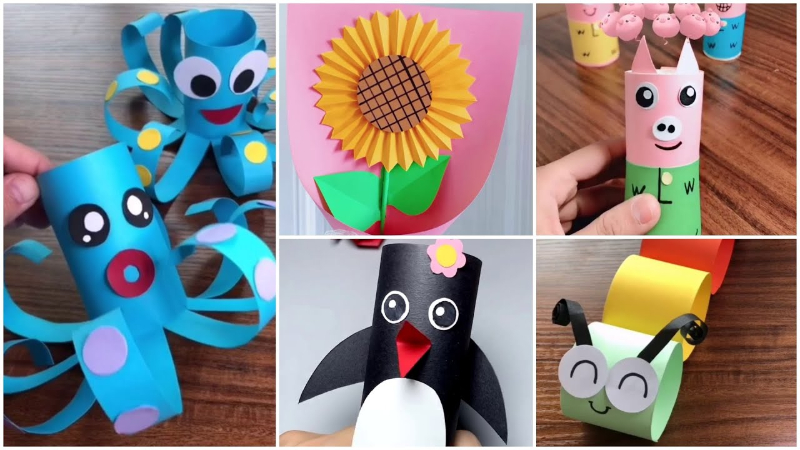In today’s fast-paced world, finding meaningful ways to engage children at home can be a challenge. As parents and caregivers, we understand the importance of DIY projects that are not only entertaining but also educational. In this comprehensive guide, we’ll explore a variety of DIY projects for kids that promote creativity, learning, and quality time together.
Introduction to DIY Projects for Kids
Engaging children in DIY activities fosters their creativity and problem-solving skills from an early age. These projects provide a hands-on approach to learning, encouraging kids to explore their interests and develop new abilities in a fun and supportive environment.
Benefits of DIY Projects for Kids
1. Promoting Creativity and Imagination
DIY projects allow children to think outside the box and explore their imaginations. Whether it’s building a cardboard castle or designing their superhero costume, these activities empower kids to express themselves creatively.

2. Encouraging Problem-Solving Skills
When faced with challenges during a project, children learn to brainstorm solutions and experiment with different approaches. This process enhances their critical thinking and problem-solving abilities, preparing them for future academic and professional endeavours.
3. Building Confidence
Accomplishing a DIY project gives children a sense of pride and accomplishment. As they see their ideas come to life, their self-esteem grows, motivating them to tackle more ambitious tasks in the future.
4. Fostering Family Bonding
Engaging in DIY activities as a family strengthens bonds and creates lasting memories. It’s an opportunity to share laughter, support each other’s creativity, and enjoy quality time together away from screens and distractions.
Popular DIY Projects for Kids
1. Nature-inspired Crafts
Bird Feeder Made from Recycled Materials
Transform a plastic bottle into a bird feeder by cutting out holes for bird access and adding perches. Decorate it with paint or coloured tape to make it visually appealing. Hang it in your garden or balcony and observe local bird species enjoying their new feeding station.
2. STEM-Based Experiments
Rainbow Volcano Science Experiment
Combine baking soda, vinegar, and food colouring to create a mini volcanic eruption. This hands-on experiment teaches kids about chemical reactions and colour mixing in a visually exciting way. It’s both educational and entertaining!
3. Art and Design Projects
DIY Tie-Dye T-Shirts
Use rubber bands to create patterns on plain white t-shirts, then apply different colours of fabric dye. After letting the dye set, rinse and wash the shirts according to dye instructions. Kids will love seeing their unique designs come to life, and they’ll have custom-made clothing to show off!
4. Upcycling Household Items
DIY Miniature Gardens from Egg Cartons
Cut sections of an egg carton and fill them with soil. Plant small herbs or succulents in each compartment and decorate with pebbles or miniature figurines. This project teaches kids about gardening and upcycling, all while adding a touch of greenery to your home.
Tips for Successful DIY Projects with Kids
1. Choose Age-Appropriate Projects
Select projects that match your child’s age, abilities, and interests. Younger children may enjoy simpler crafts involving colouring or basic assembly, while older kids can handle more complex tasks like woodworking or electronics.
2. Gather the Necessary Supplies
Before starting a project, ensure you have all the required materials and tools. This avoids interruptions and allows for a smoother crafting experience. Create a designated space where kids can work freely without the risk of making a mess.
3. Encourage Exploration and Adaptation
While it’s great to follow project instructions, encourage children to experiment with variations and personalize their creations. This encourages creative thinking and innovation, fostering a sense of ownership over their work.
4. Celebrate Achievements
Acknowledge and celebrate each child’s efforts and accomplishments, no matter how small. Display their completed projects proudly or create a gallery to showcase their creativity. Positive reinforcement motivates kids to continue exploring new ideas and challenges.
Safety Considerations for DIY Projects
1. Supervision and Guidance
Always supervise children during DIY activities, especially when using tools or materials that could pose a safety risk. Provide clear instructions and demonstrate proper techniques to ensure everyone’s safety.
2. Use of Non-Toxic Materials
Choose non-toxic and child-safe materials whenever possible, particularly when working with younger children who may explore with their hands or mouths. Verify labels and instructions to avoid exposure to harmful substances.
3. Proper Storage and Cleanup
Store tools and materials out of reach when not in use, and teach kids the importance of cleaning up after themselves. This instils responsibility and maintains a safe environment for future projects.
Incorporating Educational Themes into DIY Projects
1. Learning About Nature
Crafts involving natural materials or wildlife themes can teach children about ecosystems, biodiversity, and environmental conservation. Consider projects like building birdhouses, creating nature journals, or planting a butterfly garden.
2. Exploring History and Culture
Introduce historical or cultural themes through crafts that reflect different traditions, holidays, or significant events. This promotes cultural awareness and encourages curiosity about the world around them.
3. STEM Concepts Through Hands-On Experiments
Experiment with science, technology, engineering, and mathematics (STEM) concepts through interactive projects. From constructing simple machines to exploring robotics or coding basics, these activities nurture curiosity and problem-solving skills.
Keeping kids entertained and engaged at home can be challenging, but DIY projects offer a perfect solution. These activities not only provide hours of fun but also promote creativity, problem-solving, and learning. Here are some fantastic DIY projects for kids that can be easily done at home with common household items.
1. Homemade Playdough
Materials Needed:
- 2 cups of flour
- 1 cup of salt
- 1 cup of water
- 1 tablespoon of vegetable oil
- Food coloring (optional)
Instructions:
- Mix the flour and salt in a large bowl.
- Add water and oil, stirring until the mixture forms a dough.
- If desired, divide the dough into portions and add different food colourings to each.
- Knead the dough until smooth. If it’s too sticky, add more flour; if too dry, add more water.
Homemade playdough is a classic and simple DIY project that provides endless fun. Kids can mould, shape, and create their masterpieces, enhancing their fine motor skills and imagination.
2. Paper Plate Masks
Materials Needed:
- Paper plates
- Paints, markers, or crayons
- Scissors
- Glue
- Craft sticks
- Feathers, glitter, and other decorations
Instructions:
- Cut out eye holes in the paper plate.
- Let your child decorate the plate with paints, markers, or crayons.
- Glue on feathers, glitter, and other embellishments to create unique masks.
- Attach a craft stick to the bottom of the plate to hold the mask.
Creating paper plate masks allows children to explore their creativity and engage in imaginative play. They can make masks of animals, and superheroes, or even invent their characters.
3. DIY Bird Feeder
Materials Needed:
- Empty toilet paper roll or pine cone
- Peanut butter or vegetable shortening
- Birdseed
- String
Instructions:
- Spread peanut butter or shortening all over the toilet paper roll or pine cone.
- Roll it in birdseed until fully covered.
- Tie a string around the roll or pine cone and hang it from a tree branch.
This project is an excellent way for kids to learn about nature and wildlife. They can observe the birds that visit their feeder, fostering a connection with the environment and an interest in birdwatching.
4. Miniature Garden
Materials Needed:
- Small container or pot
- Soil
- Small plants or succulents
- Pebbles, rocks, and miniature decorations
Instructions:
- Fill the container with soil.
- Plant the small plants or succulents.
- Add pebbles, rocks, and miniature decorations to create a mini garden landscape.
Building a miniature garden teaches kids about gardening and plant care. It also encourages responsibility as they will need to water and tend to their garden regularly.

5. Cardboard Box Playhouse
Materials Needed:
- Large cardboard box
- Paints, markers, or crayons
- Scissors
- Tape or glue
Instructions:
- Open up the cardboard box and cut out windows and a door.
- Let your child decorate the box with paints, markers, or crayons.
- Use tape or glue to secure any flaps or pieces.
A cardboard box playhouse is a great way to recycle and upcycle materials. It provides a personal space for children to play and use their imagination, turning a simple box into a magical castle, cosy cottage, or bustling shop.
6. Handmade Friendship Bracelets
Materials Needed:
- Embroidery floss or yarn
- Scissors
- Tape or a clipboard
Instructions:
- Cut several strands of embroidery floss, about 12 inches long each.
- Tie a knot at one end and tape it to a table or clip it to a clipboard.
- Braid or knot the strands in different patterns to create a bracelet.
- Tie a knot at the other end to secure it.
Making friendship bracelets helps kids practice their fine motor skills and learn about patterns and sequences. They can make bracelets for themselves or give them as gifts to friends and family.
7. Salt Dough Ornaments
Materials Needed:
- 1 cup of flour
- 1 cup of salt
- 1/2 cup of water
- Cookie cutters
- Paints and brushes
Instructions:
- Mix the flour, salt, and water to form a dough.
- Roll out the dough and use cookie cutters to cut out shapes.
- Use a straw to make a hole at the top of each shape for hanging.
- Bake the shapes at 200°F (93°C) for 2-3 hours until hard.
- Once cooled, paint and decorate the ornaments.
Salt dough ornaments are a fantastic project for holidays or special occasions. Kids can create personalized decorations and keepsakes, enhancing their artistic skills and creativity.
8. DIY Lava Lamp
Materials Needed:
- Clear plastic bottle
- Water
- Vegetable oil
- Food coloring
- Alka-Seltzer tablets
Instructions:
- Fill the bottle about one-quarter full with water.
- Add vegetable oil until the bottle is nearly full.
- Add a few drops of food colouring.
- Break an Alka-Seltzer tablet into pieces and drop them into the bottle.
The DIY lava lamp is a fun science experiment that teaches kids about density and chemical reactions. The mesmerizing movement of the coloured blobs will keep them entertained and curious.

Engaging children in DIY projects at home is not just about keeping them entertained—it’s about nurturing their creativity, fostering valuable skills, and creating cherished memories together as a family. Whether you’re exploring science through experiments or expressing art through crafts, these activities provide endless opportunities for learning and growth.










